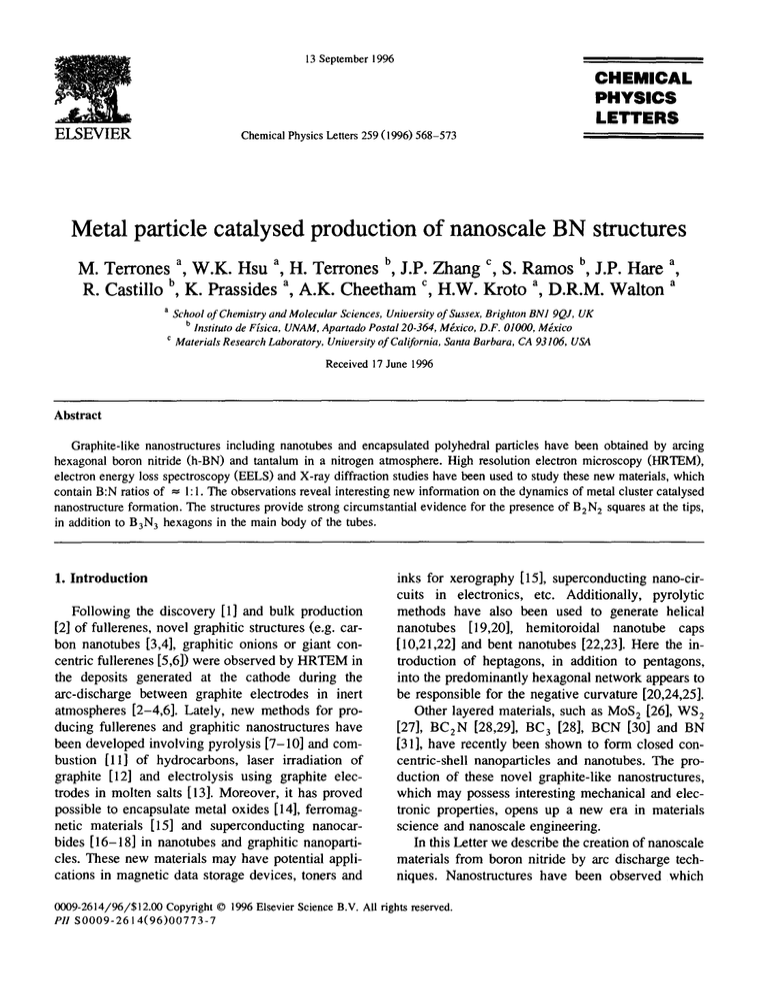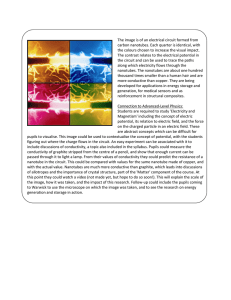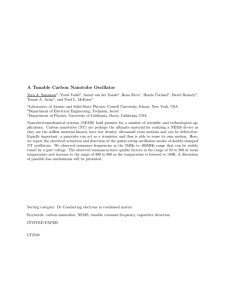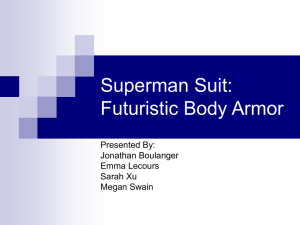
13 September 1996
CHEMICAL
PHYSICS
LETTERS
ELSEVIER
Chemical Physics Letters 259 (1996) 568-573
Metal particle catalysed production of nanoscale BN structures
a
a
b
c
b
a
M. Terrones. b ' W . K . Hsu. 'all" Terrones , J.P.c Z h a n g , S. RamoSa ' J'P" Hare a'
R. Castlllo , K. Prassldes , A.K. C h e e t h a m , H.W. Kroto , D.R.M. W a l t o n
a School of Chemistry and Molecular Sciences, University of Sussex, Brighton BN1 9QJ, UK
b Instituto de Ffsica, UNAM, Apartado Postal 20-364, M~xico, D.F. 01000, M~xico
c Materials Research Laboratory, University of California, Santa Barbara, CA 93106, USA
Received 17 June 1996
Abstract
Graphite-like nanostructures including nanotubes and encapsulated polyhedral particles have been obtained by arcing
hexagonal boron nitride (h-BN) and tantalum in a nitrogen atmosphere. High resolution electron microscopy (HRTEM),
electron energy loss spectroscopy (EELS) and X-ray diffraction studies have been used to study these new materials, which
contain B:N ratios of --- 1:1. The observations reveal interesting new information on the dynamics of metal cluster catalysed
nanostructure formation. The structures provide strong circumstantial evidence for the presence of B2N2 squares at the tips,
in addition to B3N 3 hexagons in the main body of the tubes.
1. Introduction
Following the discovery [1] and bulk production
[2] of fullerenes, novel graphitic structures (e.g. carbon nanotubes [3,4], graphitic onions or giant concentric fullerenes [5,6]) were observed by HRTEM in
the deposits generated at the cathode during the
arc-discharge between graphite electrodes in inert
atmospheres [2-4,6]. Lately, new methods for producing fullerenes and graphitic nanostructures have
been developed involving pyrolysis [7-10] and combustion [11] of hydrocarbons, laser irradiation of
graphite [12] and electrolysis using graphite electrodes in molten salts [13]. Moreover, it has proved
possible to encapsulate metal oxides [14], ferromagnetic materials [15] and superconducting nanocarbides [16-18] in nanotubes and graphitic nanoparticles. These new materials may have potential applications in magnetic data storage devices, toners and
inks for xerography [15], superconducting nano-circuits in electronics, etc. Additionally, pyrolytic
methods have also been used to generate helical
nanotubes [19,20], hemitoroidal nanotube caps
[10,21,22] and bent nanotubes [22,23]. Here the introduction of heptagons, in addition to pentagons,
into the predominantly hexagonal network appears to
be responsible for the negative curvature [20,24,25].
Other layered materials, such as MoS 2 [26], WS 2
[27], BC2N [28,29], BC 3 [28], BCN [30] and BN
[31], have recently been shown to form closed concentric-shell nanoparticles and nanotubes. The production of these novel graphite-like nanostructures,
which may possess interesting mechanical and electronic properties, opens up a new era in materials
science and nanoscale engineering.
In this Letter we describe the creation of nanoscale
materials from boron nitride by arc discharge techniques. Nanostructures have been observed which
0009-2614/96/$12.00 Copyright © 1996 Elsevier Science B.V. All rights reserved.
PII S 0 0 0 9 - 2 6 1 4 ( 9 6 ) 0 0 7 7 3 - 7
M. Terrones et a l . / Chemical Physics Letters 259 (1996) 568-573
569
are not only novel, but also provide information on
which to base a theoretical understanding of the
dynamics of the catalytic growth process.
2. Experimental
Samples were prepared using the arc-discharge dc
generator employed for fullerene production. The
anode consisted of a tantalum (99.9%) tube (4 mm
id, 5 mm od; Goodfellow Co.) press-filled with
boron nitride powder (99%, Aldrich Co). The cathode consisted of a water-cooled Cu disk (200 mm
diameter).
Before arcing, the chamber was purged twice with
nitrogen (air products 99.9% purity) and then filled
with nitrogen at - - 2 0 0 Torr. During arcing the
electrical conditions varied between 2 5 - 4 0 V and
80-150 A. The gap between the electrodes was
maintained at ~- 1 mm. As the anode rod was consumed, a grey deposit formed on the cathode (reaction time = 2 min). A few mg of this deposit were
sonicated in acetone for 5 rain and then placed on a
perforated carbon grid and the solvent was allowed
to evaporate. TEM and HRTEM measurements were
made using: JEM4000 (400 kV), Hitachi 7100 (125
kV) and a JEOL 2010 microscope equipped with a
high resolution pole piece (0.19 nm at 200 kV). A
Gatan imaging filter (GIF) system with a 1024 ×
1024 CCD camera [32] is attached to the latter
microscope for image recording and EELS spectrum
collection. This microscope was operated at 200 kV
with a LaB6 cathode, and the beam size for EELS
study was less than 3 nm. We used 0.3 eV dispersion
for EELS fine structure study while 0.5 eV dispersion was chosen to obtain the spectrum in a larger
energy range (about 500 eV) with a collecting angle
of about 5 mrad for elemental ratio calculation. Since
the thickness of the tubes is much smaller than the
mean free path of this material (the kinematical
consideration), an ideal single scattering distribution
is applied to EELS spectrum calculations.
3. Results and discussion
HRTEM and TEM studies show that the grey
deposits on the cathode contain long ( 4 - 6 / z m ) , very
thin (1.3-4.5 nm od) nanotubes ( - - 2 - 8 layers) as
Fig. 1. Moderate resolution TEM image showing a fairly representative sample of nanotubes and polyhedral particles containing
encapsulated material. The tubule with a metal particle on the tip
in the clear is shown in more detail in Fig. 3a.
well as polyhedral encapsulated particles (Fig. 1).
X-ray powder diffraction analysis (Siemens D-5000,
Cu-K,~ radiation) of the deposits clearly show the
presence of hexagonal boron nitride (interlayer spacing --- 3.33 ,~) and hexagonal Ta2N in the bulk of
the material. The exact nature of the catalytic particle
is currently the subject of investigation. Preliminary
electron diffraction (ED) data suggest the presence
of a phase isostructural with hexagonal TAB2; however, only a very small amount of this phase is
evident in the XRD profiles. It is possible that
amorphous BN starts to agglomerate at the metal or
metal boride/nitride particle, producing tubules and
polyhedral particles. We have also observed nanotubes with square and open-triangular caps, with no
metal particles. In the following section a possible
mechanism for the formation of these structures is
presented.
Fig. 2 shows a representative EELS spectrum of a
nanotube. Ionisation edges are observed at = 188 eV
570
M. Terrones et aL / Chemical Physics Letters 259 (1996) 568-573
and 399 eV which correspond to the characteristic
K-shell ionisation edges of boron and nitrogen. For
the boron and nitrogen, the sharply defined fine
structural features of the zr * and tr * pre-ionisation
edges are characteristic of sp 2 hybridisation seen in
graphite-like structures. The EELS measurements indicate that the nanotubes exhibit the expected
boron:nitrogen ratio of = 1:1 (BN).
3.1. BN structure growth catalysed by metal particles
A typical medium resolution TEM image is shown
in Fig. 1. Many of the BN tubes are quite long ( -- 5
/xm), relatively straight, and invariably ( < 85%) have
a metal particle attached to one end (Fig. 1). We
have discovered at least three types of configuration
involving catalytic particles and resulting nanostructures/nanotubes. In some cases the catalytic particle
(which appears to be TaB 2 by ED) is completely
encapsulated within the tip of a nanotube, similar to
observations reported elsewhere [ 17,18]. However, in
Fig. 3a and 3b two different configurations are observed. These reveal key features relating to the
nanotube creation process. In Fig. 3a. we see the end
of a near perfect triple-walled nanotube (seen also
under low resolution in Fig. 1) and its catalytic
particle. The structure observed is quite fascinating
as the tube appears to have extruded from one side
Fig. 3. (a) HRTEM image from a triple walled nanotube exhibiting a metal particle at the tip (see also Fig. 1). (b) Metal particle
with BN 'graphitic' layers attached. It is important to note that the
metal particle may be responsible for the nanotube growth by
subsequent agglomeration of amorphous BN around it.
B-K
150
200
250
300
350
400
450
500
Energy Loss (eV)
Fig. 2. EELS spectra showing ionisation edges at = 188 + 2 eV
and 399 4-2 eV which correspond to the characteristic K-shell
ionisation edges of boron and nitrogen respectively. The structure
of these sharp features indicates that the B and N bonding
involves sp 2 hybridisation as in graphite and normal hexagonal
BN.
of the catalytic particle. One interpretation of the
distorted sections (adjacent to the particle) is that
they are flattened tube sections which appear to gain
perfection at some distance from the particle. Thus,
they appear to become more cylindrical as they are
released from the particle's surface. A further important observation is that on the opposite side to the
nanotube formation zone there appears to be a bulky
deposit which is probably amorphous BN.
A possible mechanistic scenario is that amorphous
BN material aggregates on one side of the metal
particle and enters into a form of crystalline T a - B - N
solid solution. The B and N atoms then effectively
migrate through the metal; Iocalised thermodynamic
M. Terrones et a L / Chemical Physics Letters 259 (1996) 568-573
conditions in the nanotube construction zone then
favour segregation of layered crystalline BN. The
atoms are sufficiently well organized by interaction
with the Ta that hexagonal layers are able to self-assemble on the opposite side of the particle.
In Fig. 3a approximately six layers appear to have
formed. One possible explanation of the apparent
convergence of the layers, as they approach the
particle, is that edge-sealing (or an effective equivalent) has occurred between the edges of layers 1 and
6, 2 and 5, as well as 3 and 4. This may occur at the
same time as the layers form in the organization
zone on the side of the particle. As further BN
material segregates it lays down epitaxially at the
571
rim of the flattened tube and, as more material
forms, the middle layers are able to separate. As
further tubular BN material is shed from the particle,
the original structure, consisting of three flattened
concentric cylinders, is created and upon spooling
away from the formation zone, it springs out reminiscent of a piece of flattened rubber tubing that
has been released from compression. The result is a
perfectly cylindrical nanotube created by a remarkable exercise in nanoscale self-assembly. It is difficult to envisage a simpler process at the stage.
This, or a somewhat similar, mechanistic scenario
gains a measure of support from a second structure,
shown in Fig. 3b. Here a laminated BN sheet rather than a tube - appears to have been created on
the side of a catalytic particle. The structure appears
to be a laminated strip with perhaps a curved arc
cross-section. Such a curved cross-section would
explain the excellently well-resolved and continuous
TEM lines in Figure. 3b, which correspond to the
laminations. There is no obvious evidence that the
structure is a closed tubule. The occasional disappearance of outer-edge lines is consistent with a set
of curved sheets which lie at a slight angle to the
electron beam and is inconsistent with a tubular
construction which, if more-or-less perfect, would
not exhibit disappearing lines. This particular project
has thus shed, and is continuing to shed, fascinating
new light on the dynamic factors which govern the
nanotube creation process.
3.2. BN nanotube caps
Fig. 4. (a) HRTEM image of two overlapping nanotube caps, in
which one of them shows a clear square cap. This may be
explained by the introduction of four membered tings in the
hexagonal BN network. (b) HRTEM image of a cone-shaped
partly open cap.
Another interesting feature is the presence of
nanotubes without metal particles at their tips. Some
of these tubes exhibit closed-fiat caps, whereas, others possess open-triangular caps (Fig. 4a and 4b).
These structural phenomena are rather different from
those encountered in carbon nanotubes. In conformity with Euler's equation for even-membered rings
(12 = 2n 4 - 0 n 6 - 2 n 8) a closed, flat structure can
arise at one end of a BN nanotube if, instead of
pentagons, either three squares (Fig. 5a, 5b) or four
squares and one octagon (Fig. 5c, 5d) are introduced
in a symmetrical array into the BN hexagonal network.
It is interesting to note that square, or approximately square cross-sections are statistically quite
572
M. Terrones et al. / Chemical Physics Letters 259 (1996) 568-573
@ @ @@
a
b
c
d
Fig. 5. (a and b) Molecular model of a BN tubule cap in which three squares am equilaterally distributed over a zig-zag type hexagonal
tubule. Rotations along the tube axis show that the square shape varies and is not always a sharp well defined square. (c and d) Another BN
nanotube cap containing four squares and one octagon (armchair conformation). Rotation of this tube shows that a sharp square shape is
always preserved under any rotation along the fibre axis.
common in our study, and very unusual in carbon
nanotubes. One possible reason is that as the tube
grows, the occasional occurrence of a single fourmembered ring leads to the propagation of subsequent layers more-or-less at right-angles to the cylindrical walls. Then relatively rapid closure by a facile
annealing process may occur as the surface meets the
opposite side of the tube. The key point here is that
the occurrence of a single four-membered ring will
tend to lead to closure by a sharp relatively square
cross-section cap. For carbon nanotubes, where pentagons are the preferred non-hexagonal ring, the
advent of a single pentagonal disclination leads to a
cone.
The open-triangular cap (Fig. 4b) may form due
to the frustration in creating four-membered BN
rings along the tubule tip thus resulting in open
structures. It is important to note that the encapsulated polyhedral particles in our experiments also
exhibit sharp continuous comers where non-hexagonal or odd-membered rings appear to be present.
4. Conclusions
In addition to the closed carbon structures, it
appears that BN (--1:1 ratio) can also form
fullerene-like materials, including nanotubes and
polyhedral particles, in which metal-catalysed processes appear to be involved. We have observed that
the number of layers in the BN nanotubes is much
less when compared with carbon nanotubes produced
by plasma arcs or pyrolytic methods. This might be
due to shorter reaction times for the T a / B N experiment (~. 2 min). The present Letter provides evidence for the catalytic formation of BN nanotubes, in
which the metal particles are responsible for the BN
accretion and subsequent growth of relatively perfect
cylindrical tubules by a nanoscale self-assembly process. In addition to this catalytic process, we have
found BN nanotubes which do not contain any catalytic metal particle either on or inside the tips.
These tubules show unusual caps (closed square and
open triangular) which are thought to possess fourand perhaps also eight-membered rings in the predominantly hexagonal BN network. It is possible that
other layered materials may also form closed, bent
and curled nanotubes a n d / o r closed shell nanoparticles. The occurrence of square cross-section caps is a
characteristic of BN nanotubes which differ from
those of carbon tubes. This can be rationalised on the
basis of a preference for 4 membered rings which
may be due to the expected chemical bonding requirement that B and N atoms alternate so leading to
the absence of odd membered rings in the network.
M. Terrones et al. / Chemical Physics Letters 259 (1996) 568-573
Acknowledgements
We are grateful to Luis Rend6n (UNAM-M6xico)
for providing the HRTEM facilities. We thank
CONACYT-M6xico for funding grants 3348-E and
088P-E (to HT) and a scholarship (MT), the ORS
scheme for scholarships (MT and WKH), the Royal
Society and the ESRC for financial support. We are
particularly grateful to Dr. Alfred Bader and Dr.
Peter Doyle (ZENECA) for generous assistance.
[16]
[17]
[18]
[19]
References
[20]
[1] H.W. Kroto, J.R. Heath, S.C. O'Brien, R.F. Curl and R.E.
Smalley, Nature 318 (1985) 162.
[2] W. KP,itschmer, L.D. Lamb, K. Fostiropoulos and D.R.
Huffman, Nature 347 (1990) 354.
[3] S. Iijima, Nature 354 (1991) 56.
[4] T.W. Ebbesen and P.M. Ajayan, Nature 358 (1992) 220.
[5] S. Iijima, J. Cryst. Growth 5 (1980). 675.
[6] D. Ugarte, Nature 359 (1992) 707.
[7] R. Taylor, G.J. Langley, H.W. Kroto and D.R.M. Walton,
Nature 366 (1993) 728.
[8] C. Crowley, H.W. Kroto, R. Taylor, D.R.M. Walton, M.S.
Bratcher, P.C. Cheng and L.T. Scott, Tetrahedron Lett. 36
(1995) 9215.
[9] M. Endo, K. Takeuchi, M. Shiraishi and H.W. Kroto, J.
Phys. Chem. Solids 54 (1993) 1841.
[10] M. Endo, K. Takeuchi, K. Takahashi, H.W. Kroto and A.
Sarkar, Carbon 33 (1995) 873.
[11] J.B. Howard, A.L. Lafleur, Y. Makarovsky, S. Mitra, C.J.
Pope and T.K. Yadav, Carbon 30 (1992). 1183.
[12] T. Guo, P. Nikolaev, A.G. Rinzler, D. Tom6inek, D.T.
Colbert and R.E. Smalley, J. Phys. Chem. 99 (1995) 10694.
[13] W.K. Hsu, J.P. Hare, M. Terrones, P.J.F. Harris, H.W. Kroto
and D.R.M. Walton, Nature 377 (1995) 687.
[14] S.C. Tsang, Y.K. Chen, P.J.F. Harris and M.L.H. Green,
Nature 372 (1994) 159.
[15] M.E. McHenry, Y. Nakamura, S. Kirkpatrick, F. Johnson, S.
Curtin, M. DeGraef, N.T. Uhfer, S.A. Majetich and E.M.
[21]
[22]
[23]
[24]
[25]
[26]
[27]
[28]
[29]
[30]
[31]
[32]
573
Brunsman, in: Recent advances in the chemistry and physics
offullerenes and related materials, Vol. 2, ed. K M. Kadish
and R.S. Ruoff (1995) p. 1463.
Y. Murakami, T. Shibata, K. Okuyama, T. Arai, H. Suematsu
and Y. Yoshida, J. Phys. Chem. Solids 54 (1994) 1861.
M. Terrones, J.P. Hare, W.K. Hsu, H.W. Kroto, A. Lappas,
W.K. Maser, A.J. Pierik, K. Prassides, R. Taylor and D.R.M.
Walton, in: Recent advances in the chemistry and physics of
fullerenes and related materials, Vol. 2, ed. K M. Kadish and
R.S. Ruoff (1995) p. 599.
J.P. Hare, W.K. Hsu, H.W. Kroto, A. Lappas, K. Prassides,
M. Terrones and D.R.M. Walton, Chem. Mater. 8 (1996) 6.
S. Amelinckx, X.B. Zhang, D. Bernaerts, X.F. Zhang, V.
lvanov and J.B. Nagy, Science 265 (1994) 635.
H. Terrones, M. Terrones and W.K. Hsu, Chem. Soc. Rev.
24 (1995) 341.
A. Sarkar, H.W. Kroto and M. Endo, Carbon 33 (1995) 51.
M. Terrones, W.K. Hsu, J.P. Hare, D.R.M. Walton, H.W.
Kroto and H. Terrones, Phil. Trans. R. Soc. A (1995) in
press.
D. Bernaerts, X.B. Zhang, X.F. Zhang, S. Amelinckx, G.
Van Tendeloo, J. Van Landuyt, V. lvanov and J.B. Nagy,
Phil. Mag. A 71 (1995) 605.
A.L. Mackay and H. Terrones, Nature 352 (1991) 762.
H. Terrones, J. Fayos and J.L. Arag6n, Acta Metall. Mater.
42 (1994) 2687.
L. Margulis, G. Saltra, R. Tenne and M. Tallanker, Nature
365 (1993) 113.
R. Tenne, L. Margulis, M. Genut and G. Hodes, Nature 360
(1992). 444.
Z. Wen-Sieh, K. Cherrey, N.G. Chopra, X. Blase, Y.
Miyamoto, A. Rubio, M.L. Cohen, S.G. Louie, A. Zettl and
R. Gronsky, Phys. Rev. B 51 (1995) 11299.
M. Terrones, A.M. Benito, C. Manteca-Diego, W.K. Hsu,
O.1. Osman, J.P. Hare, D.G. Reid, H. Terrones, A.K.
Cheetham, K. Prassides, H.W. Kroto and D.R.M. Walton,
Chem. Phys. Lett. (1996) in press.
O. Stephan, P.M. Ajayan, C. Colliex, P. Redlich, J.M. Lambert, P. Bernier and P. Lefin, Science 266 (1994) 1683.
N.G. Chopra, R.J. Luyken, K. Cherrey, V.H. Crespi, M.L.
Cohen, S.G. Louie and A. Zettl, Science 269 (1995) 966.
O.L. Krivanek, A.J. Gubben, N. Dellby and C.E. Meyer,
Microsc. Microanal. Microstruct., 3 (1992) 187.








